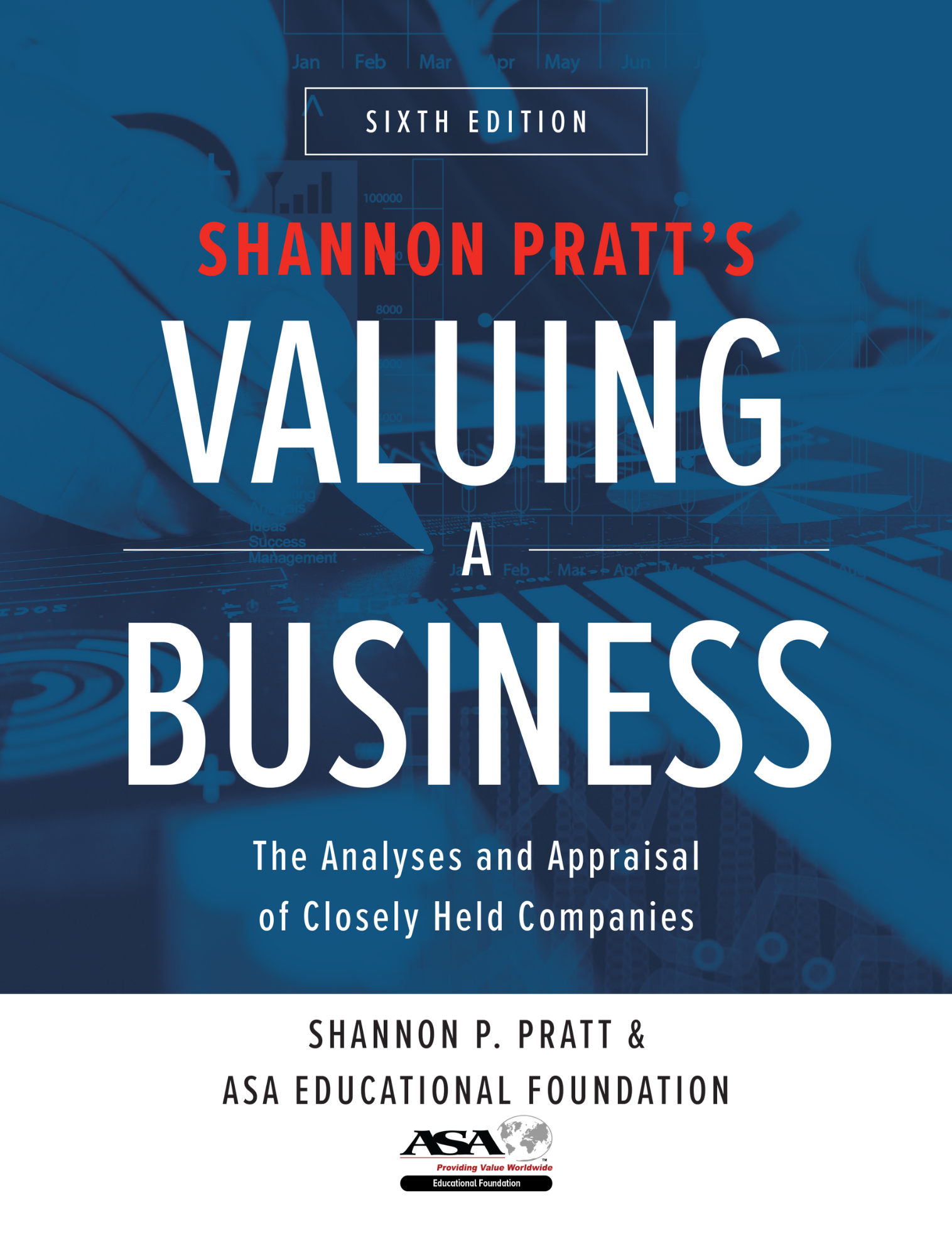

Ray Moran
Ray Moran, ASA, MRICS is Director and Chair of the Marketing Committee at iiBV. He also serves as Managing Director in the FON Valuation Services group. Prior to joining FON, he was the CEO of MG Valuation, a firm operating in 17 countries worldwide. Ray specializes in valuations for cross-border mergers and acquisitions, and valuations in the Americas, Asia/Pacific and Europe. He serves on the board of the International Institute of Business Valuers (iiBV), and chairs its marketing committee, promoting business valuation education worldwide.
Valuing a Business is one of the first textbooks on business valuation and has been instrumental in elevating business valuation as a profession. The first edition, Valuing a Business: The Analysis and Appraisal of Closely Held Companies, was authored by Shannon P. Pratt in 1981, and has been updated over the years to the current sixth edition. The book is frequently cited, referenced, and quoted in valuations, litigation, and publications worldwide, and has served as a foundational reference for business valuation education worldwide, including in the International Institute of Business Valuers (‘iiBV”) education courses. Shannon Pratt passed away in 2021, but his work continues, now sponsored by the ASA Educational Foundation, and sixty-seven leading business valuers have collaborated to update the 6th edition, spending an estimated 8,000 hours to both update existing chapters, and add new topics and an on-line appendix.
The 6th edition discusses the evolution and state of our profession, the steadily developing global and local business valuation standards, and professional education organizations and resources. Of interest to valuers outside the U.S. are the discussions regarding The International Valuation Standards Council (“IVSC”), the only global multi-disciplinary valuation standard setting organization, consisting of member Valuation Professional Organizations (“VPO’s”) and interested parties. They publish the International Valuation Standards, which are followed worldwide, with the primary objective “to promote consistency and professionalism in the public interest”. The IVS is similar to the Uniform Standards of Professional Appraisal Practice (“USPAP”), followed in the United States, and A Bridge from USPAP to IVS 2020 has been published by the The Appraisal Foundation (“TAF”) to assist valuers complying with both standards. Local VPO’s establish the education and experience requirements for valuation designations, and they will reference IVS and country-specific practices and procedures in business valuations.
The 6th edition discusses standards, several of the larger VPO’s, business valuation theory and principles, and takes the reader through the process of gathering and analysing data; valuation approaches and methods; discounts, premiums, and value conclusions; writing and reviewing business valuation reports; valuing specific assets, instruments, and interests; and litigation and dispute resolution.

VAB and the evolving business valuation profession
Valuing a Business has contributed to business valuation education worldwide. In developing valuation markets like Southeast Asia, India, and China it’s been a valuable resource. The Institute of Valuers and Appraisers (“IVAS”) in Singapore comments it’s been widely read and referenced throughout Southeast Asia; it was referenced when drafting the China Appraisal Society’s standards in 2004; and is widely known and referenced in India by the Indian Institute of Corporate Affairs, Ministry of Corporate Affairs of India for their valuation courses, and cited in litigation on topics ranging from closely held businesses, to discounts, premiums, and valuing securities. In Eastern Europe, the early editions of Valuing a Business were one of the few foundational texts available when the former Communist countries opened their markets, and the valuation profession started to grow, with an early emphasis on the privatizations of state owned businesses. The 2nd edition has been translated and used as the basis for training in the National Association of Romanian Valuers (“ANEVAR”), and used as a reference on global best practices by the National Association of Valuers of Serbia (“NAVS”).
As described in the preface to Valuing a Business (“VAB”), the book is designed to serve three purposes:
-
- A comprehensive and updated reference for business valuers
- An introductory text on business valuation for both academic and accreditation courses and beginning practitioners
- A reference for non-valuers who use and/or evaluate business appraisals
As such, it’s designed to be useful not only to business valuers but also to others dealing with business valuation issues such as attorneys, accountants, financial planners, banking professionals, investment bankers and business executives. It discusses both theoretical and practical issues and example, mentioning consensus on issues where they exist, and offering perspectives on others where there are differing opinions and lack of consensus.
A foundational resource for business valuers
Valuing a Business has been on my bookshelf since the 1980’s, and I’ve owned several editions through the years. While I’ve referred to it as a resource early in my career in the U.S., it became indispensable when I moved to Hong Kong in 2001. At the time, there wasn’t specific guidance readily available on many valuation issues and topics, and VAB was frequently referred to as an example of how specific valuation issues were addressed in more transparent markets, and applied as a guide for valuations, while following local regulatory and legal precedents. At the time I was working with valuation colleagues throughout Asia/Pacific, and VAB was a constant reference tool. Since then, I’ve worked with valuation colleagues on client projects, and business valuation education issues throughout Europe, Latin America and Southeast Asia on behalf of the iiBV. VAB is a foundational resource for the iiBV core education courses, which have been taught to over 2,500 students in 25 cities worldwide, in on-line and in-class settings. These courses are accepted by the ASA, CBV and TAQEEM as part of their requirements for professional education and accreditation. In compiling this review, I reached out to iiBV instructors, member organizations, and valuation colleagues worldwide, to share their comments and observations on VAB as a global resource.
The need for foundational publications like Valuing a Business has become even more apparent, given advances in technology, proliferation of specialized databases, and increasing demands for transparency, disclosure, and accountability in valuations. External events such as the COVID-19 pandemic and dramatic changes in the global supply chains, have resulted in several collaborative resources valuers worldwide can rely on. VAB discusses the International Valuation Glossary – Business Valuation, published by the American Society of Appraisers, CBV Institute, RICS and TAQEEM, and is referenced throughout the 6th edition and included in the Appendix.
A new age for business valuation
This edition reflects the substantial advances in the tools and sophistication in business valuation as well as new appraisal standards and regulations that have evolved since 2008. As discussed in VAB’s preface, these advances fall broadly into three categories:
-
- Increasing consensus among the valuation professional organizations on standards, methodology, and terminology
- Updated appraisal rules, regulations, standards, and guidance issued by governmental, or quasigovernmental, and professional bodies
- Major advances in the quantity, quality, and accessibility of empirical data available to support business valuation conclusions
”Valuing a Business has been on my bookshelf since the 1980’s, and I’ve owned several editions through the years. While I’ve referred to it as a resource early in my career in the U.S., it became indispensable when I moved to Hong Kong in 2001.
While there has been a growing consensus regarding business valuation issues, there also has been a growing volume of litigation over business valuations. The 6th edition summarizes the important opinions in gift, estate, charitable contribution, and income tax; shareholder and partner disputes (dissenting stockholder and minority oppression actions); marital dissolutions; and ESOP cases.
Along with the growing body of litigation, there has been a proliferation of business valuation tools in the nature of empirical databases of actual transactions. The latest on these and other databases are thoroughly described in this edition. The methodologies of measuring discounts for lack of control and discounts for lack of marketability continue to be refined. The preface mentions thirty-eight key additions to the 6th edition, a few of interest for global reference might include:
-
- Updated chapter on business valuation standards
- Updated and expanded checklist Reviewing a Business Valuation Report
- Up to date credentialing standards of all major professional associations, including ASA, AICPA, CBV, NACVA and RICS
- Expanded chapter on developing discount rates with added examples
- New chapter on valuing intangible assets
- Expanded chapter on reviewing business valuation reports, including the minimum performance requirements for financial reporting
- Expanded chapter on fair value for financial reporting
- Updated International Valuation Glossary- Business Valuation
- New online appendix with additional chapter materials
- Hundreds of updated data sources and bibliographical references in the new outline appendix
- Significantly expanded index
Several of the new chapters have comments and case studies that valuers worldwide may find useful. Regarding the chapters on discounts and premiums, Andrew Strickland, Chair of the iiBV Education Committee, mentioned “It is recognized that most of the research and empirical studies in business valuation have been undertaken in North America. They are encapsulated in this latest edition.”
The Nath hypothesis and the concept of the Market Participant Acquisition Premium (“MPAP”) as presented by The Appraisal Foundation have eroded a number of previously firm reference points: the levels of value chart, the premium for control and its inverted offspring, the discount for lack of control, have all been shown to have uncertain foundations. Against this change in the landscape, it is pleasing to note that the authors have judiciously navigated a route that is responsive to these challenges.
Chapter 3 introduces a new chart at exhibit 3-2 to describe the levels of value in a post MPAP world. The market value of the stocks of public companies may represent a control value unless the cash flows can be increased or risks reduced. Chapter 17 is particularly good at describing the nuanced complexities relating to questions of control and its absence. It does this by relating the realities of control to both public and private companies. The importance of considering the impacts on cash flows is rightly emphasized: discounts for lack of control must focus on the applicable cash flows and any governance deficits. Chapter 18 addresses the acquisition premium. It strives to embrace differing views as to the nature of takeover premium evidence from the public markets.
There is deeper recognition of the intertwined relationship of the discount for lack of control and the discount for lack of marketability. Chapter 19 surveys the sources of evidence for the DLOM in a comprehensive way, from restricted stock studies through to the mathematical models of Chaffe, Finnerty, Ghaidarov and others.”
Graham Antrobus, of the iiBV Education Committee offered the following comments on Part 6, in particular on the valuation of specific assets, instruments and interests looks at topics which will be of interest to valuers whatever their geographic location.
Chapter 25 gives an overview of the valuation of intangible assets. It is comprehensive enough to cover the reasons why such an asset might need to be valued including financial reporting, tax and litigation before looking in some depth at the various approaches to value including the income, market and cost approaches. Perhaps most instructive of all, under the income approaches, are subsections relating to the derivation of appropriate discount rates for intangible assets and the application of the Tax Amortization Benefit relating to the asset in question.
Chapters 26, 27 and 30 give broad and wide coverage to a trio of topics which can throw valuers outside of the proverbial “comfort zone”. VAB6 explains how the valuation of debt securities, preferred securities and complex capital structures can all be taken back to first principles. However, none of these chapters are oversimplified such as to ignore the nuances attaching to their topics. The chapter on debt securities, for example, looks in some detail at the structural characteristics that attach to debt instruments whilst the chapter on complex capital structures uses the novel application of case studies to show how the current value, option pricing, hybrid and probability weighted expected returns methodologies all work in practice.
Chapter 28 provides the reader with a toolkit on the valuation of stock options. As expected, the “go to” models including Black Scholes, Binomial and Monte Carlo simulation all receive in depth coverage. However, the chapter takes things a stage further with a detailed discussion of Real Option Valuation.
Valuers looking for guidance on writing and reviewing business valuation reports, can refer to guidance in chapters 22 – Writing the Business Valuation Report; Chapter 23 – Sample Report; and Chapter 24 – Reviewing a Business Valuation Report. The chapters were written by Trey Stevens, Chair, ASA International Board of Examiners, who reviews submitted reports for ASA accreditation, and Trey has commented “in many developing valuation markets, it’s apparent to reviewers when reviewing for professional accreditation that many of the reports were prepared by practitioners that may have never seen a valuation report before. While the chapters in VAB are U.S. centric, they discuss the topics and levels of supporting documentation a BV report should have. The sample report and valuation checklist will provide some guidance to those starting out in the profession that aren’t familiar with valuation reports.”
Trey continues the discussion on report writing and by adding, “while not specific to these chapters, when I started off in the profession, I relied heavily on VAB, especially in terms of the discussions of common errors that are made. While much of the focus in teaching valuation principles is on what to do, learning what not to do is perhaps the most important and VAB stands out in this area.” These observations were further discussed by Edwina Tam, Board member of the iiBV “For a market like Hong Kong where there are no mandated business valuation standards within the profession, you see a wide degree of quality in valuation reports that are produced. The chapter on Reviewing a Business Valuation Report, although U.S. centric, is a great reference for all practitioners globally to see what ‘good’ looks like and will ensure the report contains the essential information required for a reader to understand the context of the valuation analysis as well as provide a checklist for practitioners to ensure a robust valuation analysis. ”
Chapter 45, Valuations for Financial Reporting, mentions the similarities between the two largest accounting boards: the International Accounting Standards Board (“IASB”) and the Financial Accounting Standards Board (“FASB”) in the U.S.. These two organizations issue the International Financial Reporting Standards (“IFRS”) and generally accepted accounting principles (“GAAP”) which are adhered to for financial reporting engagements. The chapter discusses the valuation credential Certified in Entity and Intangible Valuations (“CEIV”), along with its companion piece the Mandatory Performance Framework (“MPF”), which discussed scope, due diligence and documentation that should be included in engagements for financial reporting. While the CEIV is a US centric designation, many valuers worldwide have met the education and accreditation requirements, to assist in their cross-border engagements regarding GAAP.
Writing the 6th edition of Valuing a Business was a complex task, with the ASA Educational Foundation agreeing to be the sponsoring organization, a six-person steering committee including Ken Pia (Marcum, LLP), Jeff Tarbell (Houlihan Lokey), Jay E. Fishman Financial Research), Matt Crow (Mercer Capital), Roger Grabowski (Kroll) and Johnnie White (ASA CEO). They assembled two co-authors per chapter, with the forward thinking of having a younger individual assigned to each chapter team, to continue to produce the 7th and future editions. This process resulted in sixty-seven contributing authors, forty-five reviewers, a select group of judges, attorneys and academics who reviewed advance copies, all while ensuring the book maintained an easy-to-read style, consistent with prior editions. The reviewers noted Valuing a Business, 6th Edition remains primarily U.S. centric, with an overview of global standards and practices, and are hopeful future editions might include additional comments on standards, practices, and regulations worldwide. Given the ever-increasing number of country specific standards, that may not be possible in a single volume, but the authors succeeded in their goals of providing an easy-to-read publication, describing complex valuation theory, examples, and case studies.

